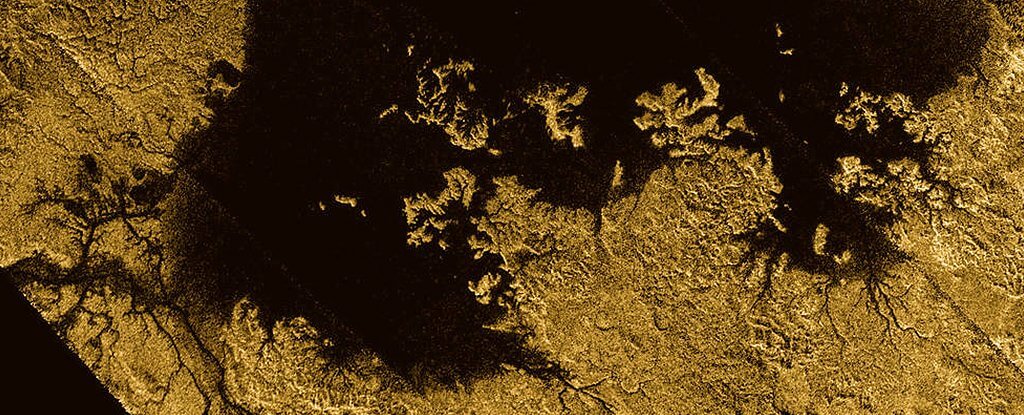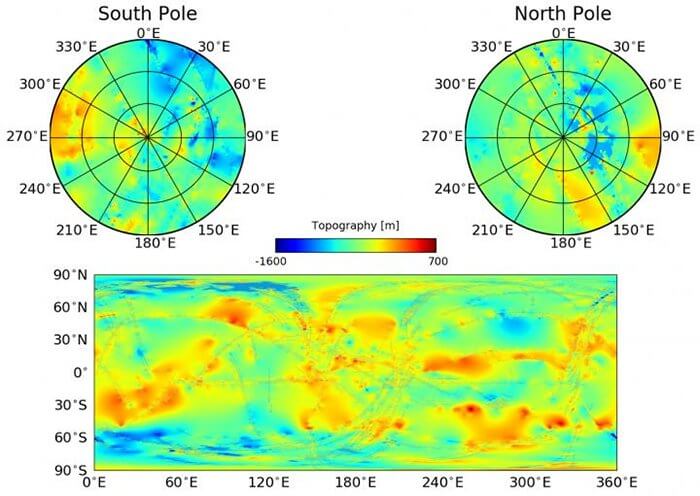- Get link
- X
- Other Apps

More than ten years have passed since the Cassini spacecraft transmitted the first clear images of Titan, the largest satellite of the planet Saturn. Astronomers spent years trying to disassemble all the data provided by the device, and finally presented the first topological map of the satellite's surface to the world. It turned out that Titan has much more in common with the Earth than one would have expected.
Like the Earth, Titan has liquid seas. True, unlike water, the seas on the satellite of Saturn consist of superfluid hydrocarbon compounds. Perhaps another remarkable difference is that the surface of these seas is very calm, one can say, mirror-clean. Nevertheless, not only the seas companion is like our planet.
Astronomers from Cornell University used the latest received topographic data from Titan and found that the three largest seas of the satellite have the same equipotential surface - a sea level, like our oceans. This fact in itself is of great interest for scientists, but more striking is that the researchers in general were able to find out even such details.

"We measured the level of the surface fluid on another cosmic body, located 10 astronomical units from the Sun, with an accuracy of about 40 centimeters," explains Alex Hayes, an astronomer at Cornell University.
"We measured the geoid of Titan. This is the form that the satellite's surface takes under the influence of gravity and rotation. A similar form, that is, the form of the geoid, is our Earth. "
Interestingly, the data obtained also contain information that hints at some features of the distribution and motion of liquid hydrocarbons on the satellite, mainly represented as condensed methane and ethane molecules. Scientists assume that the seas of the satellite have the same level due to the fact that they can be connected by certain channels, either located on the surface or under it. These channels are large enough so that the liquid can be evenly distributed on the surface. According to the same Hayes, the second option (with subsurface channels) is more likely.
"We do not see any empty lakes, whose level would be below the level of local lakes. Even if this level is reduced, then after a time it rises again. This can mean that there are channels under the surface of lakes, through which liquid can be distributed between the pools, "says Hayes.
In addition, it can also say that the reserves of liquid hydrocarbons on Titan can be much larger than can be seen at first glance.
A topological map can help astronomers better understand how the liquid is distributed over the satellite, but at the same time opens up a new puzzle that requires a solution. Some fluid-filled depressions on the surface are very reminiscent of geological structures, well known on Earth and called karsts. They are associated with the activity of water and are expressed in the dissolution of rocks and the formation of voids in them, as well as peculiar forms of relief.
As on Earth, Titan's karst structures do not have obvious channels through which fluid could flow between them. But, unlike our karsts, Titan's tartar has sharp, sharp edges. Scientists suspect that these depressions are expanding. The largest lake in Titan, located in the south, also looks amazing. It is a fluid filled karst, combined together.
"Many things for us still remain incomprehensible. For example, solving the karst problem may be the key to understanding the evolution of Titan's polar basins, "says Hayes.
Maybe Cassini is no longer with us - recall, the probe was deliberately dropped on Saturn - but his legacy and discoveries will continue to amuse our curiosity about Saturn and his companions for many years to come.
The article is based on materials .
- Get link
- X
- Other Apps
Comments
Post a Comment